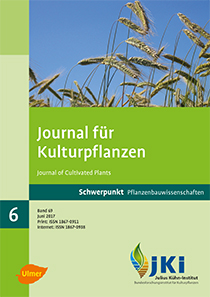Development of biological plant protection methods, in particular the use of beneficials, in Baden-Wuerttemberg since 1979: a survey with new data from 2013 and 2014
DOI:
https://doi.org/10.5073/JfK.2017.06.02Keywords:
Biocontrol, commercial beneficials, entomopathogenic nematodes, plant strengtheners, organic farmingAbstract
In order to monitor the progress of biological plant protection, surveys have been conducted every 2 years in the State of Baden-Wuerttemberg, Germany during the last 35 years. This survey is the oldest and most comprehensive regional survey of this kind in Germany and focuses in particular on the use of beneficial arthropods.
In 1979, mainly the parasitic wasp Encarsia formosa and the predatory mite Phytoseiulus persimilis were applied. For E. formosa, the treated area has increased fifty times from 3.0 ha in 1979 to 153.4 ha in 2014 and almost ninety times for P. persimilis from 1.4 ha (1979) to 122,5 ha (2014). Since the early 1990 s, additional beneficial organisms, including lacewings (2014: 28.0 ha), Ambylseius predatory mites (2014: 237.3 ha), beneficial gall midges (2014: 91.8 ha) and various aphid parasitoids (2014: 173.7 ha) were available and made it possible to apply almost exclusively biological crop protection in cultures like vegetable crops under glass or in plastic tunnels. During 2014, 28 species of beneficials were used in the greenhouses of Baden-Württemberg and the total treated area had increased to 423 ha. This means, the treated area has more than doubled during the last decade. The use of beneficials in greenhouse vegetables, strawberries and herbs (2014: 324.6 ha) expanded in the early 1990 s to ornamental plants (2014: 64.4 ha). Additional beneficials like nematodes and microorganisms have been used during the last 15 years in outdoor vegetables (2014: 922.2 ha) and ornamentals (2014: 83.2 ha). A new category was added during the current survey, greenhouse berry fruits (2014: 85.3 ha), where predominantly beneficial arthropods are used.
Over the years, the types of beneficials used has also expanded and covers now, apart from beneficial arthropods, entomopathogenic nematodes like Heterorhabditis and Steinernema species (2014: 99 ha) as well as beneficial microorganisms (2014: 880 ha) which includes those used for pest control (2014: 169 ha, e.g. Bacillus thuringiensis), as soil conditioners (2014: 593 ha, e.g. Bacillus amyloliquefaciens), and beneficial fungi (2014: 104 ha, e.g. Conithyrium minitans). In orchards, the most important biocontrol methods are the use of a granulovirus against the codling moth (2014: 640 ha) and the application of pheromones for mating disruption (2014: 536 ha), similar to the use in vineyards. An additional area of biological control which was not directly covered by the survey is the use of parasitic Trichogramma wasps against the European corn borer which has expanded during the last 30 years to about 20,000 ha. Various Trichogramma species are also available for apples and plums, mainly in home gardens against tortricid pests. Further, biological control methods have been developed over the years for applying beneficial insects in stored products, both in post-harvest grain storage against moths and beetles as well as in pest control in households, for example, against food moths.
The analysis of the survey results shows a significant increase in the area treated with beneficial organisms, the use in a larger variety of cultures and a wider variety of benefical arthropods and microorganisms applied. Currently, there is no area of plant cultivation without biocontrol methods.
Downloads
Published
Issue
Section
License
The content of the journal is licensed under the Creative Commons Attribution 4.0 License. Any user is free to share and adapt (remix, transform, build upon) the content as long as the original publication is attributed (authors, title, year, journal, issue, pages).
The copyright of the published work remains with the authors. The authors grant the Journal of Cultivated Plants, the Julius Kühn-Institut and the OpenAgrar repository the non-exclusive right to distribute and exploit the work.







